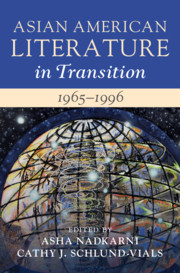Book contents
- Asian American Literature in Transition, 1965–1996
- Asian American Literature In Transition
- Asian American Literature in Transition, 1965–1996
- Copyright page
- Contents
- Contributors
- Series Preface
- Introduction
- Part I Immigration, Migration, and Movement
- Chapter 1 Scrutinizing Impossible Subjects
- Chapter 2 The Model Minority and Debt
- Chapter 3 Displaced Subjects and Refugee Literature, 1965–1996
- Chapter 4 1.5 Generation Literature as Asian Americanist Critique
- Part II Politics, Art, and Activism
- Part III Institutionalization and Canon Formation
- Part IV Diaspora and the Transnational Turn
- References
- Index
Chapter 2 - The Model Minority and Debt
from Part I - Immigration, Migration, and Movement
Published online by Cambridge University Press: 08 June 2021
- Asian American Literature in Transition, 1965–1996
- Asian American Literature In Transition
- Asian American Literature in Transition, 1965–1996
- Copyright page
- Contents
- Contributors
- Series Preface
- Introduction
- Part I Immigration, Migration, and Movement
- Chapter 1 Scrutinizing Impossible Subjects
- Chapter 2 The Model Minority and Debt
- Chapter 3 Displaced Subjects and Refugee Literature, 1965–1996
- Chapter 4 1.5 Generation Literature as Asian Americanist Critique
- Part II Politics, Art, and Activism
- Part III Institutionalization and Canon Formation
- Part IV Diaspora and the Transnational Turn
- References
- Index
Summary
This chapter explores how debt shaped the Asian American subject, most notably through its creation of the model minority subject. It argues that debt, a fundamental aspect of neoliberalism, structured the racialization of Asian Americans; this facilitated the production of the model minority as the exemplary neoliberal subject, characterized by acceptance of human capitalization and independence from the public sector through “resilience.” Surveying Asian American literature from 1965 to 1996, this chapter examines the role that debt played in the historical patterns and processes of Asian migration to the United States that tied the racialization of Asian Americans to their economic contributions and value. Moving beyond the more explicit connections between migration and debt, the chapter illustrates how ideas of debt and indebtedness manifest and structure conceptions of nationalism in the Asian American subject and family; the ability to immigrate inherently incurs indebtedness to the nation as well as to one’s parents who chose to immigrate. Thus, the concept of filial piety is reframed, showing that it is not a result of ancestry, but a function of immigration to America.
Keywords
- Type
- Chapter
- Information
- Asian American Literature in Transition, 1965–1996 , pp. 34 - 48Publisher: Cambridge University PressPrint publication year: 2021

